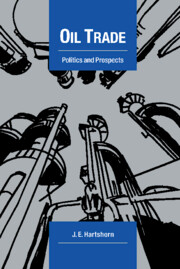Book contents
- Frontmatter
- Contents
- List of figures
- List of tables
- List of tabular boxes
- Preface
- List of abbreviations
- 1 Pause or plateau?
- 2 A discontinuity in trade
- 3 Cost: concepts and comparisons
- 4 Ambitions of autarky?
- 5 Still the prime mover
- 6 An industry restructured
- 7 Governments in the oil business
- 8 The Opec performance
- 9 A confusion of prices
- 10 Perspectives of supply
- 11 A contrast of expectations
- 12 A sustainable paradox?
- Appendix 1 What are oil reserves?
- Appendix 2 A note on energy and oil statistics
- Bibliography
- Index
3 - Cost: concepts and comparisons
Published online by Cambridge University Press: 27 January 2010
- Frontmatter
- Contents
- List of figures
- List of tables
- List of tabular boxes
- Preface
- List of abbreviations
- 1 Pause or plateau?
- 2 A discontinuity in trade
- 3 Cost: concepts and comparisons
- 4 Ambitions of autarky?
- 5 Still the prime mover
- 6 An industry restructured
- 7 Governments in the oil business
- 8 The Opec performance
- 9 A confusion of prices
- 10 Perspectives of supply
- 11 A contrast of expectations
- 12 A sustainable paradox?
- Appendix 1 What are oil reserves?
- Appendix 2 A note on energy and oil statistics
- Bibliography
- Index
Summary
As well as their prodigious reserves, the main Gulf producers have so far enjoyed lower production costs for oil than those of any other energy in the world. These two elements of their rich natural endowment are distinct, though associated. The amount of oil in place in any reservoir depends on the total volume and the porosity of reservoir rock that it contains. The proportion of this resource that can be recovered, and the rates of production one can achieve from it, depend mainly on:
the permeability of the rock by which oil can flow through the
reservoir, and the viscosity of the particular oil contained there; and
the natural energy contained in the reservoir that drives the oil up
towards the bottom of the well, such as surrounding or underlying water; gas compressed within a ‘cap’ above the oil in the pores of the reservoir rock; or gas bubbles forming within the oil reservoir.
But many other factors also affect costs. Not all the world's super-giant fields have low production costs: two of those most recently discovered, Tenghiz in the former USSR and the much-debated Chicontapec in Mexico, up to the time this book was completed, had not proved economic even to begin developing.
It is hardly surprising that the Middle East's lion's share of world reserves has so far been developed more cheaply than the smaller reserves elsewhere. The huge concessionary areas granted to companies from the beginning, often nationwide, allowed ‘unitisation’ of the development of large reservoirs under single management, without the wasteful sub-division that had often occurred in the history of the US oil industry.
- Type
- Chapter
- Information
- Oil TradePolitics and Prospects, pp. 50 - 75Publisher: Cambridge University PressPrint publication year: 1993

